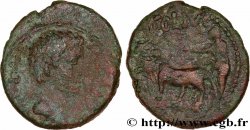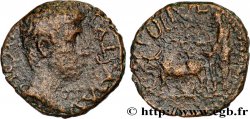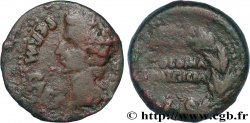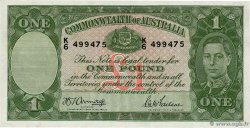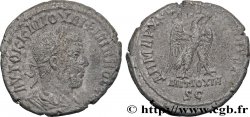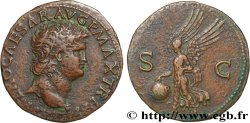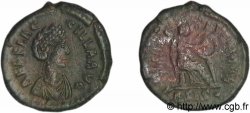v36_0356 - AUGUSTO Unité
MONNAIES 36 (2008)
Начальная цена : 100.00 €
Назначить цену : 150.00 €
Цена реализации : 100.00 €
Количество ставок : 1
Максимальная предлагаемая цена : 111.00 €
Начальная цена : 100.00 €
Назначить цену : 150.00 €
Цена реализации : 100.00 €
Количество ставок : 1
Максимальная предлагаемая цена : 111.00 €
Тип Unité
Дата: 12 AC. - 14 AD.
Монетный двор / Город: Acmonée, Phrygie
Металл: copper
Диаметр: 18,5 mm
Ориентация осей монеты: 12 h.
Вес: 4,97 g.
Редкость: R2
Комментарии о состоянии
Exemplaire sur un petit flan épais, bien centré des deux côtés, mais un peu court sur les légendes. Beau portrait. Faiblesse de frappe au revers. Patine marron foncé, légèrement granuleuse
Лицевая сторона
Аверс: описание: Tête nue d’Auguste à gauche (O°1) ; devant la tête un lituus.
Аверс: легенда: [S]EBASTOS
Аверс: перевод: (Auguste).
Обратная сторона
Реверс: Описание: Niké (Victoire) drapée, marchant à droite, brandissant une couronne de la main droite et tenant une palme de la main gauche.
Реверс: легенда: AKMONE[WN] - KORDOS
Реверс: перевод: (Acmonéon - Cordos).
Комментарий
Pour ce type, les auteurs du Roman Provincial Coinage ont recensé six exemplaires avec six coins de droit, un poids moyen de 5,12 g pour quatre exemplaires. C’est le septième exemplaire signalé. Outre les deux exemplaires conservés à Londres, l’exemplaire du Cabinet des médailles de la BnF provient de la collection Waddington (n° 5484) et nous avons aussi un exemplaire à Berlin et un autre à Vienne. Le dernier est conservé au Staatliche museum de Münich. La présence du lituus devant le visage d’Auguste nous fait penser pour une datation postérieure à 13 avant J.-C. après la mort de Lépide quand Auguste recupère le titre de Pontifex Maximus (grand pontife), c’est à dire, chef de la religion traditionnelle romaine.
For this type, the authors of the Roman Provincial Coinage have identified six examples with six obverse dies, an average weight of 5.12 g for four examples. This is the seventh example reported. In addition to the two examples preserved in London, the example in the Cabinet des médailles of the BnF comes from the Waddington collection (no. 5484) and we also have one example in Berlin and another in Vienna. The last one is preserved at the Staatliche Museum in Munich. The presence of the lituus in front of the face of Augustus suggests a dating later than 13 BC after the death of Lepidus when Augustus recovered the title of Pontifex Maximus (high pontiff), that is to say, head of the traditional Roman religion.
For this type, the authors of the Roman Provincial Coinage have identified six examples with six obverse dies, an average weight of 5.12 g for four examples. This is the seventh example reported. In addition to the two examples preserved in London, the example in the Cabinet des médailles of the BnF comes from the Waddington collection (no. 5484) and we also have one example in Berlin and another in Vienna. The last one is preserved at the Staatliche Museum in Munich. The presence of the lituus in front of the face of Augustus suggests a dating later than 13 BC after the death of Lepidus when Augustus recovered the title of Pontifex Maximus (high pontiff), that is to say, head of the traditional Roman religion.








 Cообщить об ошибке
Cообщить об ошибке Распечатать страницу
Распечатать страницу Отправить мой выбор
Отправить мой выбор Задать вопрос
Задать вопрос Consign / sell
Consign / sell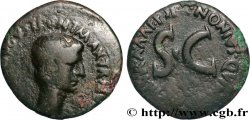
 Информация
Информация
